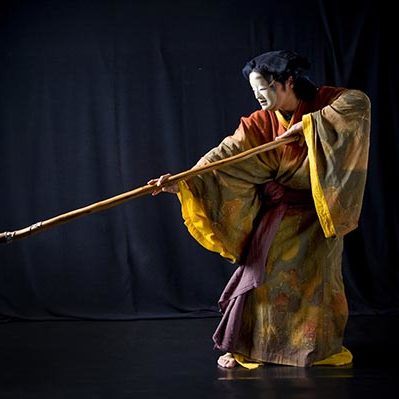At The American School in England (TASIS) Diploma Programme (DP) students learn and participate in Noh, one of the world’s oldest forms of theatre.

By Esther Clark
“There is beauty in the subtle, in the silence, in the present, in what is expressed in between the actor’s movements,” says Nikki Holdaway, head of The American School (TASIS) England’s theatre department, as she gazes out the window and a smile lightens up her face: “you don’t always need to, ‘go big.’”
We are discussing Noh theatre as a stunning example of when art imitates life and provides a soft critique of society, as well as an invitation for us to be present and mindful of other cultures and perspectives.
Noh (能) is a 14th century form of theatre that involves drama, music and dance and it originates from Japan. The movements are slow and the language tends to be poetic. The plots are inspired by literature, history, legend and contemporary events while themes involve dreams and the supernatural. The tone is monotonous and the costumes are heavy and rich in texture and design. The IB theatre students at TASIS have the opportunity to study Noh through their world traditions unit, as part of a multifaceted theatre-making course.
Ms. Holdaway, a Noh artist herself, began training five years ago at Royal Holloway University and continued her studies in Tokyo, working with professional Noh actors. She explains how important it is that teachers are learners as well. When in Japan, she was part of the first cohort of westerners to train at the Kita School of Noh. Each day, Ms. Holdaway worked on the revered Noh stage and was taught the basic elements of Noh theatre: Juitai (chorus), Hayashi (drumming) and Shimai (dancing) both individually and in groups.

She describes how everyone’s learning journey is different and because she is both an IB theatre teacher and learner, she can empathize with her students and make her IB theatre class richer in content and experience. TASIS Diploma Programme (DP) students can make theatre as creators, designers, directors and performers.
Sergio, a grade 12 student, is excited to share how he engaged actively in the creative process, transforming ideas into action as an inquisitive and productive artist.
“Learning about Noh was the breaking of our artistic assumptions regarding the potentiality of theatre,” he explains.
Sergio was particularly interested in Noh and decided that this would be his research focus: “Noh connected us with the roots of theatre and made us aware of how important it is in maintaining a powerful emotional connection between the audience and the performer. This is what differentiates the art from other mediums.”
Statements like these illustrate how students play their part, contextualize their work and appreciate other cultures―including ancient theatre cultures such as Noh. Bryan Nixon, head of school at TASIS England connects it to the school’s commitment to Intercultural learning: “the process through which we acquire knowledge and understanding through an awareness of our own culture, engagement with other cultures and perspectives and explorations into local and global issues to enable us to interact and communicate in appropriate and effective ways in intercultural situations.”
An example of learning in action is when Japanese, “Intangible Cultural Asset”, and Noh Master, Akira Matsui visited the school this past September and gave a workshop to IB theatre students. It wasn’t about being loud; it was about control and stillness, about the beautiful patterns that an artist creates on the floor with his/her movements―like the patterns of a Japanese (Zen) sand garden.
In the words of a TASIS student: “We all agreed that Noh taught us to become connected with the present moment. We all agreed that it could be the most lacking feature of the global society today.”
If you are an IB World School or an IB student and you wish to share your story with us, please write to us at communications@ibo.org. We appreciate your ongoing support and invite you to connect with us on LinkedIn, Twitter and now Instagram!
If you enjoyed this story, consider reading more below:



